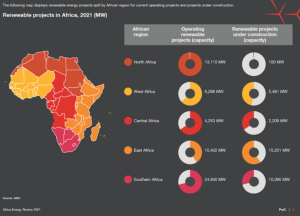Looking just at oil, PwC data show that production significantly decreased by 19% to 6.8 mmbbl/d from the prior year. This accounts for 7.8% of global production. Consumption saw a decrease of 14% to 3.5 mmbbl/d from the prior year, and exports saw a drop to 5.7 mmbbl/d.
“Despite companies commencing exploration and development projects, planned capital expenditure in 2020–2021 fell from $90 billion pre-COVID-19 to $60 billion,” the report titled Africa Energy Review 2021 reads.
The other side of the coin is renewables, which are on the rise across the continent with an annual growth rate of 21% between 2010 and 2020 and a current total renewable capacity of more than 58 GW – of which hydropower contributes 63%.
The consultancy firm reports that wind energy generation increased by 14% and solar energy generation increased by 13%, while total renewable energy generation increased by 11% in 2020 compared to the previous year. Solar capacity increased by 13%, wind capacity increased by 11% and hydropower increased by more than 25% in 2020 compared to 2019.

“Most African countries are also increasing investment in solar and hydropower technologies with projects currently under construction estimated to add 33 GW of renewable energy capacity,” the review states. “Total installed renewable energy capacity in Africa has grown by over 24 GW since 2013. The continent’s capacity is expected to increase again by the end of 2021 with growth led by solar and wind projects in Egypt, Algeria, Tunisia, Morocco, and Ethiopia.”
Despite these positive trends, mid-term forecasts can look daunting, as PwC says that 27.32 EJ of additional renewable generation is needed within Africa’s energy mix by 2050 to compensate for declining fossil fuels. This is a significant increase from the current renewable generation of just 1.79 EJ.
“Africa’s coal and oil energy production are expected to drop by around 96% and 71% respectively by 2050. This will be driven by declining demand for fossil fuels globally with leading international oil and gas companies already refocusing their portfolios to include higher renewables exposure,” the document reads. “Renewable energy is expected to see large gains in Africa over the next three decades. By 2050, energy production from solar and wind is expected to increase by as much as 110 times and 40 times respectively.”
In the view of the experts at PwC, employment levels in the energy sector will depend greatly on the way the energy transition takes place.
They believe that if Africa is pressured into rapidly transitioning to renewables and is assisted in this process through renewable energy funding, the transition of workers away from fossil fuel-related jobs will be much faster. This means that the potential loss of jobs can be mitigated.
Net-zero goals
Although Africa is home to 17% of the global population, it produces less than 5% of global annual emissions and accounts for only 3% of global cumulative emissions.
Yet, 35 out of 54 African countries have made commitments towards net-zero emissions, a goal that is unaffordable for most of them as an estimated $2.8 trillion are needed just to transition to a clean energy mix and reduce its current annual CO2 emissions of 1.62m kilotons of CO2e.
“Investment in low-carbon energy systems in Africa lags global pace, but despite global climate finance commitments from developed economies aimed at $100bn per annum, the allocation to Africa falls significantly short of what the continent requires to meet global targets. The fiscal constraints being experienced across Africa create a challenge for the continent to move with pace on its net-zero journey,” the report reads.
For the analysts at PwC, private partnerships, public-private partnerships and blended finance are key and will need to be deployed together with strong public sector governance and innovative financing instruments to overcome these challenges.




